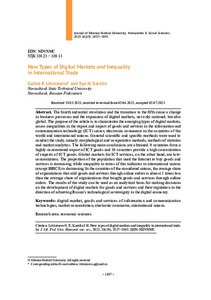Новые виды цифровых рынков и неравенство в международной торговле
Автор:
Литвинцева, Г. П.
Карелин, И. Н.
Litvintseva, Galina P.
Karelin, Ilya N.
Дата:
2023-10Журнал:
Журнал Сибирского федерального университета. Гуманитарные науки. Journal of Siberian Federal University. Humanities & Social Sciences; 2023 16 (10)Аннотация:
Четвертая промышленная революция и переход к пятой вызывают
изменение бизнес-процессов
и расширение цифровых рынков, не только
национальных, но и глобальных. Цель статьи – охарактеризовать развивающиеся
виды цифровых рынков, оценить неравенства в экспорте и импорте товаров и услуг
сектора информационно-коммуникационных
технологий (ИКТ), электронной
торговле в странах мира и международных союзах. Для проведения исследования
использовались общенаучные и специфические методы, а именно морфологические
и сравнительные методы, методы статистики и рыночной аналитики. Получены
следующие основные выводы: 9 стран формируют высококонцентрированный экспорт
товаров ИКТ и 10 стран обеспечивают высокую концентрацию импорта товаров ИКТ.
Мировые рынки услуг ИКТ, наоборот, низкоконцентрированные. Количество людей,
использующих Интернет для покупки товаров и услуг, увеличивается, а неравенство
по этому показателю в международных союзах (кроме БРИКС) снижается. В странах
рассмотренных союзов средняя доля организаций, продававших товары и услуги
по онлайн-заказам,
меньше средней доли организаций, покупавших товары и услуги
по онлайн-заказам,
почти в 2 раза. Результаты исследования могут быть использованы
в качестве аналитической основы для принятия решений о развитии цифровых рынков
товаров и услуг и их регулировании в направлении достижения технологического
суверенитета России в цифровой экономике The fourth industrial revolution and the transition to the fifth cause a change in business processes and the expansion of digital markets, not only national, but also global. The purpose of the article is to characterize the emerging types of digital markets, assess inequalities in the export and import of goods and services in the information and communication technology (ICT) sector, electronic commerce in the countries of the world and international unions. General scientific and specific methods were used to conduct the study, namely morphological and comparative methods, methods of statistics and market analytics. The following main conclusions are obtained. 9 countries form a highly concentrated export of ICT goods and 10 countries provide a high concentration of imports of ICT goods. Global markets for ICT services, on the other hand, are low-concentration. The proportion of the population that used the Internet to buy goods and services is increasing, while inequality in terms of this indicator in international unions (except BRICS) is decreasing. In the countries of the considered unions, the average share of organizations that sold goods and services through online orders is almost 2 times less than the average share of organizations that bought goods and services through online orders. The results of the study can be used as an analytical basis for making decisions on the development of digital markets for goods and services and their regulation in the direction of achieving Russia’s technological sovereignty in the digital economy

